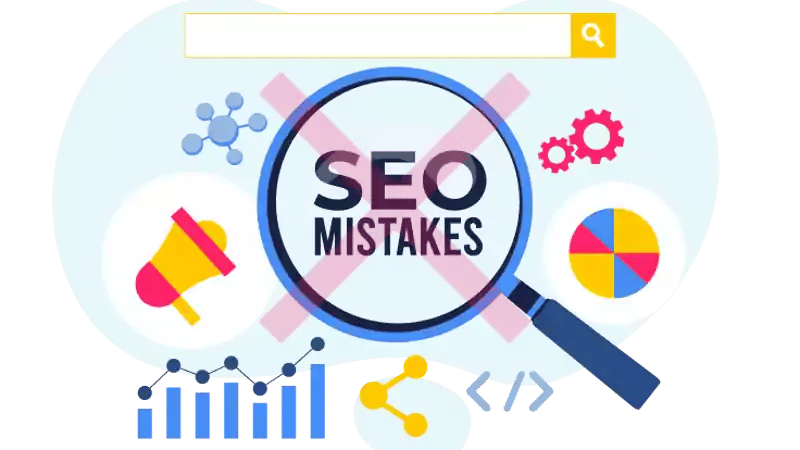Deblocați succesul SEO: Aflați cum folosim HubSpot Hub de conținut pentru SEO, cum stimulăm clasamentele și cum creștem traficul organic.
Uggh. Nu! 5 greșeli SEO comune de evitat
Optimizarea pentru motoarele de căutare (SEO) este esențială pentru marketingul online în peisajul digital de astăzi. Un site web bine optimizat poate ajuta întreprinderile să crească vizibilitatea online, să conducă trafic și să genereze clienți potențiali. Cu toate acestea, este important să rețineți că nu toate strategiile SEO sunt create la fel. Mulți comercianți fac greșeli comune care pot avea un impact negativ asupra poziționării site-ului lor în paginile cu rezultatele motoarelor de căutare (SERP).
Pentru a vă asigura că eforturile dvs. SEO sunt cât mai eficiente posibil, iată care sunt cele mai frecvente cinci greșeli de evitat.

1. Umplerea cu cuvinte cheie
Este destul de cunoscut faptul că utilizarea cuvintelor cheie este esențială pentru clasarea în motoarele de căutare. Ca atare, poate fi ușor să credeți că ar trebui să adăugați toate cuvintele-cheie posibile în conținutul dvs. Cu toate acestea, această "umplutură" de cuvinte cheie poate fi contraintuitivă pentru clasificarea SEO.
Umplerea cu cuvinte cheie este o greșeală SEO comună pe care mulți comercianți o fac pentru a manipula clasamentul în motoarele de căutare. Umplerea cu cuvinte-cheie implică utilizarea excesivă a cuvintelor-cheie pe un site web până în punctul în care acesta devine nefiresc și spam. Această practică poate duce la o penalizare din partea motoarelor de căutare, afectând negativ clasamentul unui site web în paginile cu rezultatele motoarelor de căutare (SERP).
În timp ce umplerea cu cuvinte-cheie obișnuia să fie o strategie SEO eficientă în primele zile ale motoarelor de căutare, motoarele de căutare de astăzi au devenit mai sofisticate. Ca urmare, algoritmii lor au evoluat pentru a penaliza site-urile care se angajează în această practică. Astăzi, umplerea cu cuvinte-cheie este o tactică învechită pe care ar trebui să o evitați.
Unul dintre cele mai comune exemple de umplutură de cuvinte cheie este atunci când un site web repetă același cuvânt cheie în mod repetat în conținut. Acest lucru nu numai că face conținutul nefiresc, dar îl face și dificil de înțeles pentru cititori. Un alt exemplu este ascunderea cuvintelor-cheie pe un site web prin transformarea textului în aceeași culoare ca și fundalul. Această tehnică, denumită "text invizibil", este o tactică SEO black hat care poate duce la o penalizare din partea motoarelor de căutare.
Cuvinte-cheie cu grijă
Pentru a evita umplerea cu cuvinte-cheie, marketerii ar trebui să se concentreze pe crearea de conținut de înaltă calitate care să ofere valoare cititorilor. În loc să repete același cuvânt-cheie de mai multe ori, aceștia ar trebui să utilizeze variații și să încorporeze termeni înrudiți pentru a face conținutul mai natural. De asemenea, este esențial să se asigure că conținutul este relevant pentru publicul țintă și că îi oferă valoare.
O regulă generală bună este să folosiți trei până la patru cuvinte-cheie pe post. Încercați să utilizați un cuvânt-cheie principal și câteva cuvinte-cheie de coadă lungă corespunzătoare. În timp ce câteva cuvinte cheie suplimentare pot apărea în mod natural în text, acest lucru este mai natural decât umplerea cu cuvinte cheie.
2. Ignorarea optimizării mobile
Ignorarea optimizării mobile este o altă greșeală SEO comună pe care marketerii o fac adesea. Având în vedere că majoritatea traficului pe internet provine de pe dispozitive mobile, optimizarea site-urilor web pentru utilizatorii mobili este esențială. Eșecul în acest sens poate duce la o experiență slabă a utilizatorului, la scăderea clasamentului în motoarele de căutare și la îndepărtarea utilizatorilor de site-ul web.
Această practică (sau lipsa acesteia) poate duce la o serie de probleme pentru site-urile web. De exemplu, site-urile web care nu sunt optimizate pentru dispozitivele mobile pot avea timpi de încărcare lenți, ceea ce poate frustra utilizatorii și îi poate determina să părăsească site-ul web. În plus, utilizatorii de dispozitive mobile pot avea dificultăți în navigarea pe site-urile web care nu sunt optimizate pentru dispozitive mobile, ceea ce duce la o experiență de utilizare deficitară.
Pagini web prietenoase cu dispozitivele mobile
Pentru a evita această greșeală, creați un site web mobil-friendly cu o experiență excelentă pentru utilizatori. Acest lucru poate fi realizat prin intermediul designului web receptiv, care ajustează aspectul și conținutul site-ului pentru a se potrivi cu dimensiunea ecranului dispozitivului. Designul web responsiv asigură că site-ul web este ușor de navigat și oferă o experiență de utilizare fără cusur pe desktop și pe dispozitive mobile.
O altă modalitate de a optimiza un site web pentru utilizatorii de dispozitive mobile este îmbunătățirea timpilor de încărcare. Utilizatorii mobili sunt adesea în mișcare și au răbdare limitată, astfel încât este esențial să se asigure că site-ul se încarcă rapid. Acest lucru poate fi realizat prin optimizarea imaginilor, comprimarea fișierelor și reducerea numărului de solicitări HTTP.
S-ar putea să-ți placă și:
3. Neglijarea SEO On-Page
SEO On-page este un aspect critic al optimizării pentru motoarele de căutare pe care mulți marketeri îl neglijează. Acesta se referă la optimizarea paginilor web individuale pentru a le îmbunătăți clasamentul în paginile cu rezultatele motoarelor de căutare (SERP). Neglijarea SEO on-page poate duce la o experiență proastă a utilizatorului, la scăderea clasamentului în motoarele de căutare și la scăderea traficului către un site web.
Neglijarea SEO on-page presupune neoptimizarea paginilor web individuale pentru motoarele de căutare. Aceasta poate include neincluderea cuvintelor-cheie relevante în conținut, utilizarea de imagini de calitate slabă sau neoptimizarea meta-tag-urilor site-ului. În plus, neglijarea SEO pe pagină poate implica, de asemenea, neoptimizarea structurii site-ului și a legăturilor interne.
Acordați atenție SEO On-Page
Pentru a evita neglijarea SEO on-page, agenții de marketing ar trebui să se concentreze pe optimizarea paginilor web individuale pentru motoarele de căutare. Acest lucru poate include efectuarea de cercetări privind cuvintele-cheie și utilizarea cuvintelor-cheie relevante în conținut. De asemenea, ar trebui să vă asigurați că structura site-ului este optimizată pentru motoarele de căutare, cu o ierarhie clară a paginilor, construirea de linkuri interne cu texte de ancorare relevante și o navigare ușor de utilizat.
O altă modalitate de optimizare a SEO pe pagină este optimizarea etichetelor meta ale site-ului. Etichetele meta sunt fragmente de text care apar pe paginile cu rezultate ale motoarelor de căutare și descriu pe scurt conținutul site-ului. Optimizarea metaetichetelor poate contribui la îmbunătățirea ratei de clic (CTR) a site-ului în paginile de rezultate ale motoarelor de căutare, ceea ce poate duce la creșterea traficului către site.
4. Conținutul duplicat
Conținutul duplicat este o altă greșeală comună pe care o fac marketerii. Acesta se referă la conținutul care apare pe mai multe pagini web sau pe mai multe site-uri web. Motoarele de căutare penalizează site-urile web care utilizează conținut duplicat, deoarece le poate fi dificil să determine ce versiune a conținutului să indexeze și poate scădea calitatea generală a rezultatelor căutării.
Conținutul duplicat poate apărea din diverse motive, inclusiv copierea conținutului de pe alte site-uri web, utilizarea aceluiași conținut pe mai multe pagini sau utilizarea conținutului de la alții pe același site web. Deși conținutul duplicat nu este întotdeauna intenționat, acesta poate duce totuși la o penalizare din partea motoarelor de căutare.
Creați conținut original
Pentru a evita această greșeală, concentrați-vă pe crearea de conținut unic și original care să ofere valoare cititorilor. Aceasta poate include efectuarea de cercetări amănunțite și crearea de conținut informativ, atractiv și relevant pentru publicul țintă. Este esențial să vă asigurați că conținutul site-ului este unic și nu copiat de pe alte site-uri sau pagini de pe același site. În esență, evitați tăierea colțurilor și utilizați conținut original (exclusiv).
De asemenea, este util să utilizați etichete canonice pentru a evita problemele legate de conținutul duplicat. Etichetele canonice sunt etichete HTML care indică motoarelor de căutare care versiune a unei pagini web este versiunea "master". Acest lucru poate ajuta la prevenirea penalizării unui site web de către motoarele de căutare pentru conținut duplicat.
O altă modalitate de a evita problemele legate de conținutul duplicat este utilizarea fișierelor robots.txt pentru a împiedica motoarele de căutare să indexeze anumite pagini web. Acest lucru poate fi util pentru paginile care conțin conținut duplicat sau pentru paginile irelevante pentru motoarele de căutare.
5. Neglijarea experienței utilizatorului
Neglijarea experienței utilizatorului este o altă greșeală SEO comună pe care marketerii o fac adesea. Experiența utilizatorului (UX) se referă la experiența generală a unui utilizator atunci când vizitează un site web, inclusiv designul, navigarea, conținutul și funcționalitatea site-ului. Neglijarea experienței utilizatorului poate duce la o experiență slabă a utilizatorului, ceea ce duce la o rată ridicată de respingere, un angajament scăzut și o clasare mai slabă în motoarele de căutare.
Prioritizarea UX
Pentru a evita neglijarea experienței utilizatorului, concentrați-vă pe crearea unui site web ușor de utilizat, ușor de navigat și care să ofere valoare utilizatorilor. Acest lucru poate necesita efectuarea de cercetări privind utilizatorii și înțelegerea nevoilor și preferințelor publicului țintă. De asemenea, trebuie să vă asigurați că designul site-ului web este atrăgător din punct de vedere vizual și ușor de utilizat, cu o navigare simplă și un apel clar la acțiune.
O altă modalitate de a optimiza experiența utilizatorului este să vă asigurați că conținutul site-ului este informativ, atractiv și relevant pentru publicul țintă. Acest lucru poate include crearea unui conținut ușor de citit, utilizarea de imagini și clipuri video pentru a despărți textul și asigurarea faptului că conținutul site-ului este actualizat și corect.
De asemenea, ar trebui să vă concentrați pe optimizarea vitezei de încărcare a site-ului. Un site web care se încarcă lent poate duce la o experiență proastă a utilizatorului, ceea ce duce la o rată ridicată de respingere și la o clasare mai slabă în motoarele de căutare. Comercianții ar trebui să optimizeze imaginile site-ului, să utilizeze memoria cache pentru a accelera timpul de încărcare a site-ului și să elimine orice pluginuri sau scripturi inutile care pot încetini performanța site-ului.
Pregătiți-vă SEO pentru succes
O bază SEO solidă este vitală pentru a ajuta întreprinderile să își îmbunătățească vizibilitatea online și să atragă mai mult trafic organic către site-urile lor web. Având în vedere că din ce în ce mai mulți consumatori apelează la motoarele de căutare pentru a găsi produse și servicii, o strategie SEO solidă este esențială pentru ca întreprinderile să rămână competitive pe piețele lor respective.
SEO ajută întreprinderile să își optimizeze site-urile web pentru motoarele de căutare, facilitând parcurgerea, indexarea și clasificarea conținutului acestora de către motoarele de căutare. Prin clasarea mai sus în paginile de rezultate ale motoarelor de căutare, întreprinderile vor crește gradul de conștientizare a mărcii și vor spori traficul și conversiile și vânzările. Dar, pentru ca agenții de marketing să asigure eficiența eforturilor lor SEO, aceștia trebuie să evite aceste greșeli frecvente.
Cum vă poziționați în SEO? Descărcați lista noastră de verificare gratuită pentru a afla.
Acest conținut este disponibil și în:
- Germană: Igitt. Nein! 5 häufige SEO-Fehler, die es zu vermeiden gilt
- Engleză: Uggh. No! 5 Common SEO Mistakes to Avoid
- Spaniolă: Uggh. No! 5 errores comunes de SEO que debe evitar
- Franceză: Uggh. Non ! 5 erreurs courantes de référencement à éviter
- Italiană: Uggh. No! 5 errori comuni di SEO da evitare
- Chineză: 不不!应避免的 5 个常见搜索引擎优化错误









Lasă un comentariu cu părerea ta.